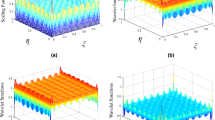Abstract
The B-spline wavelets element technique developed by Chen and Wu (1995a) is extended to the membrane vibration analysis. The tensor product of the finite splines and spline wavelets expansions in different resolutions is applied in the development of a curved quadrilateral element. Unlike the process of direct wavelets adding in the previous work, the elemental displacement field represented by the coefficients of wavelets expansions is transformed into edges and internal modes via elemental geometric conditions and “two-scale relations”. The “multiple stages two-scale sequence” of quadratic B-spline function is provided to accelerate the sequential transformations between different resolution levels of wavelets. The hierarchical property of wavelets basis approximation is also reserved in this extension. For membrane vibration problems where variations lack regularity at certain lower vibration modes, the present element can still effectively provide accurate results through a multi-level solving procedure. Some numerical examples are studied to demonstrate the proposed element.
Similar content being viewed by others
References
Amaratunga, K.; Williams, J. R. (1993): Wavelet based Green's function approach to 2D PDEs. Eng. Comp. 10, 349–367
Chen, W. H.; Wu, C. W. (1995): A spline wavelets element method for frame structure vibration. Comp. Mech. 16, 11–21
Chen, W. H.; Wu, C. W. (1996): Adaptable spline element for membrane vibration analysis. Int. J. Numer. Meth. Eng. accepted
Fox, L.; Herrici, P.; Moler, C. (1967): Approximations and bounds for eigenvalues of elliptic operators. SIAM J. Num. Ana. 4, 89–102
Irie, T.; Yamada, G.; Ashida, K. (1982): Vibrations of cross-shaped, I-shaped, and L-shaped membranes and plates. J. Acoust. Soc. Am. 72, 460–465
Ko, J.; Kurdila, A. J.; Pilant, M. S. (1994): A class of wavelet-based finite elements for computational mechanics. Pro. of the 35th Structures, Structural Dynamics and Materials Conference, Hilton Head, South Carolina, 665–675
Latto, A.; Resnikoff, H. L.; Tenenbaun, E. (1991): The evaluation of connection coefficients of compactly supported wavelets. Technical Report AD910708, Aware Inc.
Magrab, E. B. (1979): Vibration of elastic structural members. The Netherlands: Sijthoff & Noordhoff
Qian, S.; Weiss, J. (1993): Wavelets and the numerical solution of partial differential equations. J. Comp. Phys. 106, 155–175
Xu, J. C.; Shann, W. C. (1991): Galerkin-wavelets methods for two-point boundary value problems. Report No. AM 85, University of Penn. State
Author information
Authors and Affiliations
Additional information
Communicated by S. N. Atluri, 22 January 1996
Rights and permissions
About this article
Cite this article
Wu, C.W., Chen, W.H. Extension of spline wavelets element method to membrane vibration analysis. Computational Mechanics 18, 46–54 (1996). https://doi.org/10.1007/BF00384175
Issue Date:
DOI: https://doi.org/10.1007/BF00384175



